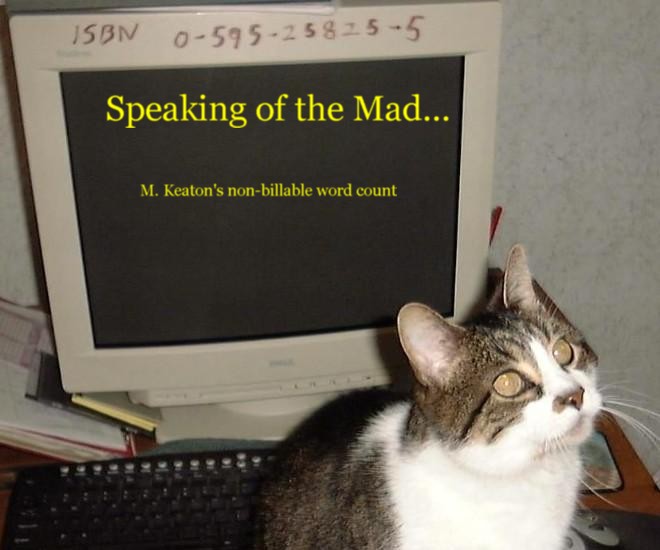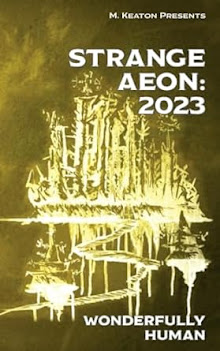I think it will be interesting to see the development of certain themes in the steampunk genre over the coming years. Most steampunk uses a pseudo-Victorian era setting and this was a time that had several pronounced cultural issues at work. The oppression of women and open racism were the accepted norm and an almost casual level of violence permeated most cultures of the time period. On the positive side, imperialism still held sway and the industrial revolution had not yet spread to completely subjugate the agrarian culture. Needless to say, by using this time period as a backdrop—a time period firmly straddling a whole host of cultural and social developments—the genre has huge potential to explore a vast number of issues. Right now, most steampunk works concentrate more on entertainment and action but the deeper, more thematic works will come as the genre grows.
One item that specifically interests me will be the push and pull between feminism and misogyny within the genre. There is a possible historic template in the development of science-fiction and fantasy that may play out here as well. Both SF and fantasy were originally male oriented (and male dominated) genres. So much so that entire subsections of fantasy were labeled by critics as “male masturbatory literature” (for example, Robert Howard’s Conan stories, the Horse Clans series, and John Norman’s Gor books). In time, however, dames pushed their way into the genre and began to assert their own views, both as writers and as an ever-increasing portion of the reading (buying) market. Eventually the pendulum swung so far that, by the time LeGuin and Bradley were big names, mainstream fantasy was more of a vehicle for feminist propaganda than actual good storytelling. (Okay, maybe I generalize a little much and maybe, just maybe, I’m tweaking some people by using terms like “dames” but the general point is a sound one.) Today, the genre has mostly leveled out although it still leans “female” because of the shift in buying power within the market (more women buy books than men).
But, will this happen in steampunk? Obviously the misogynistic elements are readily apparent in the oppressive, paternalism of the Victorian era but will history repeat itself? I don’t know. One could argue against it because the current steampunk movement already has a strong female presence among both writers and readers. Cherie Priest certainly doesn’t skimp on strong women as characters in her books.
However, there is the extenuating fact that steampunk is not only a literary genre but also an aesthetic—that it includes and plays to a certain visual style bringing in influences outside just the written word. If you examine steampunk fans at public gatherings and the outfits they wear, you will notice that the women are not, as a rule, rejecting the physical symbols of Victorian oppression. Rather, they are embracing them—corsets and painful shoes are in abundance. What does it mean, if it is relevant at all? I don’t know and that’s why I’m interested in watching the trends.
It may be that the costuming is irrelevant to the literature but steampunk relies heavily on the aesthetic for much of its current definition. Will the genre split and create an eroticized sub-category or will the possible issues be completely swept under the rug by the strong tide of homogenization that seems to swamp any new and emerging artistic trend? Could it be that sometimes chicks just like to be frail and frilly and that there’s nothing intrinsically misogynistic about it?
Cynically, one might ask if it is relevant at all because steampunk may be a short-lived fad and nothing more. I doubt this for three reasons. One, although not labeled as steampunk, this style has always been present and used in SF/F. Two, because steampunk does span beyond just literature into apparel, music, and the like, and therefore it has a stronger base and a wider audience footprint than one might suspect. And three, because steam is one of the cheapest special effects to create and movies and TV drive most of the entertainment industry—simple economics predicts longevity.
Perhaps a more significant issue might be why the genre is so appealing. SF/F, so long noted for looking forward, is now clearly turning back and focusing on a previous, and one might say more comfortable, and more structured time. Does this indicate a growing fear of technology and a society that on some level fears it is losing control of its own devices? Is it a kind of literary nostalgia for a “better time”? A reaction to an overwhelming array of gadgets and internet connectivity invading into our personal lives?
Or is it a generation finally waking up to the fact that the age of Imperialism was a fascinating time in the development of Western culture and therefore a great setting for exciting stories?
As I’ve said, I don’t know but I think the answers may be worth looking for.
Wednesday, November 10, 2010
Sunday, November 7, 2010
Alternative payment structures for authors in an internet based economy now that the royalty structure may be obsolete
In one of the panels at Conclave, the question was asked: now that royalty payments are infeasible, how are writers going to get paid? Are there any new ideas out there? The question didn’t get answered and I thought I’d address it here.
Let me explain a bit of the background to the issue. Traditionally, writers are paid royalties, an amount of money per book sold. This is usually around 4-6% of the cover price so when you buy a seven dollar paperback, the author gets an amount around 35 cents. (Numbers vary depending on binding and other factors.) Needless to say, you have to sell a lot of books to make money. (Typically, the author is paid an up-front “advance against royalties” and then starts getting royalty payments after the advance is “earned out”. The average advance is somewhere around five thousand dollars per book and most authors don’t earn out. As a rule of thumb, if you assume that your local author is getting five to seven grand a book total, you’ve got a pretty good view of the writing economy. Don’t quit your day job.)
The problem with the royalty model in an internet based economy (and the reason that most writers expect that something will have to change) is the e-book. E-books are cheap and getting cheaper. I could go off on a rant about how the real problem is that the market doesn’t see the creative effort of writing a book as having monetary value and therefore thinks the only real costs are in paper but that’s not the point. The point is, if an author can’t make a decent living on 5% of seven bucks, then 5% of two bucks isn’t worth the effort to write the book. (Think of it: one morning someone invents an internet application and suddenly you take an almost 80% pay cut.) So something’s got to change in the way authors get paid, but what?
The answer is: nobody knows. In the near-term, it’s going to get worse before it gets better. There will be a lot of different things tried, some better than others, and a lot of places will stick with the royalty model as long as possible.
But the question was asked if there are any other feasible alternatives that anyone has considered and I believe there is one—one that has the advantage of having been used successfully before.
Patronage.
Before dismissing the idea as crazy, hear me out. Patronage has a fine history in the arts. After all, Dante didn’t write the Inferno on spec. Nobles patronized artists, artists provided books, music, paintings, sculptures, and so on to please their patrons and life went on. I know some people will yell that patronized art is corrupted and not true to the artists visions but, frankly, these people don’t know very much about the market or history. In actuality, patronage provides for a wider range of expression because, instead of having to cater to a marketing demographic or federal grant program, the artist only has to please one person—their patron—and individuals have much broader tastes and tolerances than homogenized cultures.
But are there enough rich people willing to patronize and make the idea work? Let’s go back to history. Why did the nobility and the church patronize artists to begin with? Some were altruistic but most were after two simple things: propaganda and public image. Either art to support and promote a specific agenda or art so that the common man would say “Well, that baron supports this theater and that writer and these paintings and even though I ain’t happy with the taxes, at least he ain’t such a bad feller all the way around. Let’s put off the revolt until next week.”
Now go watch TV for a few minutes and look at the ads. Notice that a lot of them aren’t for products or services; they’re general touchy-feely our company isn’t evil, we’re your friend kind of ads. In other words, public image ads. That tells you that the market and the money are there. You have a clear potential, no only for individual patronage, but also patronage by charitable organizations, foundations, schools, research institutes, and the entire scope of corporate America.
Let’s make it even more fun. Let’s say that a corporation decides to sponsor an author and that they make a portion of that author’s writing (and maybe that author’s time) available for free to schools and libraries. Think about it. On every bookshelf, from bookstores to supermarkets, the sponsor’s corporate logo has replaced the publisher’s imprint (massive brand exposure) plus now it’s going into schools and libraries too. Why wouldn’t a corporation spring for that? You could buy a dozen authors for the price of a Super Bowl ad.
And what about stocks? What if you could buy a percentage of your favorite author? If a group of you could go together, buy stock in an author, and jointly support his or her work? Especially is the author threw in some nice bonuses like signed first edition copies for all stock holders, exclusive beta reads and deleted scenes, character cameos of preferred holders, etc.? We could end up with a much broader market selection that we have now where only two major publishers rule most of the field.
I’m not saying it’s going to happen and I’m not saying whether it would be good or bad for society but I am saying that it is a plausible, feasible alternative.
Let me explain a bit of the background to the issue. Traditionally, writers are paid royalties, an amount of money per book sold. This is usually around 4-6% of the cover price so when you buy a seven dollar paperback, the author gets an amount around 35 cents. (Numbers vary depending on binding and other factors.) Needless to say, you have to sell a lot of books to make money. (Typically, the author is paid an up-front “advance against royalties” and then starts getting royalty payments after the advance is “earned out”. The average advance is somewhere around five thousand dollars per book and most authors don’t earn out. As a rule of thumb, if you assume that your local author is getting five to seven grand a book total, you’ve got a pretty good view of the writing economy. Don’t quit your day job.)
The problem with the royalty model in an internet based economy (and the reason that most writers expect that something will have to change) is the e-book. E-books are cheap and getting cheaper. I could go off on a rant about how the real problem is that the market doesn’t see the creative effort of writing a book as having monetary value and therefore thinks the only real costs are in paper but that’s not the point. The point is, if an author can’t make a decent living on 5% of seven bucks, then 5% of two bucks isn’t worth the effort to write the book. (Think of it: one morning someone invents an internet application and suddenly you take an almost 80% pay cut.) So something’s got to change in the way authors get paid, but what?
The answer is: nobody knows. In the near-term, it’s going to get worse before it gets better. There will be a lot of different things tried, some better than others, and a lot of places will stick with the royalty model as long as possible.
But the question was asked if there are any other feasible alternatives that anyone has considered and I believe there is one—one that has the advantage of having been used successfully before.
Patronage.
Before dismissing the idea as crazy, hear me out. Patronage has a fine history in the arts. After all, Dante didn’t write the Inferno on spec. Nobles patronized artists, artists provided books, music, paintings, sculptures, and so on to please their patrons and life went on. I know some people will yell that patronized art is corrupted and not true to the artists visions but, frankly, these people don’t know very much about the market or history. In actuality, patronage provides for a wider range of expression because, instead of having to cater to a marketing demographic or federal grant program, the artist only has to please one person—their patron—and individuals have much broader tastes and tolerances than homogenized cultures.
But are there enough rich people willing to patronize and make the idea work? Let’s go back to history. Why did the nobility and the church patronize artists to begin with? Some were altruistic but most were after two simple things: propaganda and public image. Either art to support and promote a specific agenda or art so that the common man would say “Well, that baron supports this theater and that writer and these paintings and even though I ain’t happy with the taxes, at least he ain’t such a bad feller all the way around. Let’s put off the revolt until next week.”
Now go watch TV for a few minutes and look at the ads. Notice that a lot of them aren’t for products or services; they’re general touchy-feely our company isn’t evil, we’re your friend kind of ads. In other words, public image ads. That tells you that the market and the money are there. You have a clear potential, no only for individual patronage, but also patronage by charitable organizations, foundations, schools, research institutes, and the entire scope of corporate America.
Let’s make it even more fun. Let’s say that a corporation decides to sponsor an author and that they make a portion of that author’s writing (and maybe that author’s time) available for free to schools and libraries. Think about it. On every bookshelf, from bookstores to supermarkets, the sponsor’s corporate logo has replaced the publisher’s imprint (massive brand exposure) plus now it’s going into schools and libraries too. Why wouldn’t a corporation spring for that? You could buy a dozen authors for the price of a Super Bowl ad.
And what about stocks? What if you could buy a percentage of your favorite author? If a group of you could go together, buy stock in an author, and jointly support his or her work? Especially is the author threw in some nice bonuses like signed first edition copies for all stock holders, exclusive beta reads and deleted scenes, character cameos of preferred holders, etc.? We could end up with a much broader market selection that we have now where only two major publishers rule most of the field.
I’m not saying it’s going to happen and I’m not saying whether it would be good or bad for society but I am saying that it is a plausible, feasible alternative.
Subscribe to:
Comments (Atom)




















